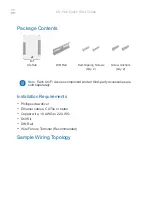
Description
When SMCLK is used as the clock source for the ADC (ADC12CTL1.ADC12SSELx =
11) and CSCTL4.SMCLKOFF = 1, the ADC will stop operating if the ADC clock source is
changed by user software (e.g. in the ISR) from SMCLK to a different clock source. This
issue appears only for the ADC12CTL1.ADC12DIVx settings /3/5/7. The hang state can
be recovered by PUC/POR/BOR/Power cycle.
Workaround
1. Set CSCTL4.SMCLKOFF = 0 before switch ADC clock source.
OR
2. Only use ADC12CTL1.ADC12DIVx as /1, /2, /4, /6, /8
AES1
AES Module
Category
Functional
Function
Ongoing AES operation cannot be aborted by writing to AESAXIN
Description
Writing to AESAXIN register when AESASTAT.AESBUSY bit is set does abort the ongoing
AES operation or set the AESACTL0.AESERRFG bit.
Workaround
Always let AES operation run to completion (i.e. do not abort). Ignore the encryption/
decryption output if AESAXIN is written when AESASTAT.AESBUSY is set.
AUXPMM1
AUXPMM Module
Category
Functional
Function
AUXVCC1/AUXVCC2 can not be switched back to DVCC
Description
When the system is running with the AUXVCC1 supply after DVCC/AVCC is lost, if the
AUXVCC1 voltage goes lower than SVSH setting for POR and above BORH level, the
system can not switch back to DVCC after DVCC ramps back up again.
Similarly, when the system is running with the AUXVCC2 supply after DVCC/AVCC is lost,
if the AUXVCC2 voltage goes lower than SVSH setting for POR and above BORH level,
the system can not switch back to DVCC after DVCC ramps back up again.
Workaround
When the system is running with the AUXVCC1 supply, use SVMH to monitor AUXVCC1
voltage. When AUXVCC1 is lower than the SVMH setting, the program drives the chip
into LPMx.5. After DVCC ramps up back again, trigger one of the wake up pins. The
power supply could be switched back to DVCC again.
When the system is running with the AUXVCC2 supply, use SVMH to monitor AUXVCC2
voltage. When AUXVCC2 is lower than the SVMH setting, the program drives the chip
into LPMx.5. After DVCC ramps up back again, trigger one of the wake up pins. The
power supply could be switched back to DVCC again.
AUXPMM2
AUXPMM Module
Category
Functional
Function
Latch-up in AUXPMM
Description
Latch-up current can appear at the AUXPMM module supply pins in the following two
scenarios:
Scenario 1: When the AUXPMM is configured for hardware- or software-controlled
switching and the module switches from DVCC to AUXVCC2, latch-up current can
Advisory Descriptions
SLAZ475AD – DECEMBER 2012 – REVISED MAY 2021
MSP430F6778 Microcontroller
7
Copyright © 2021 Texas Instruments Incorporated








































